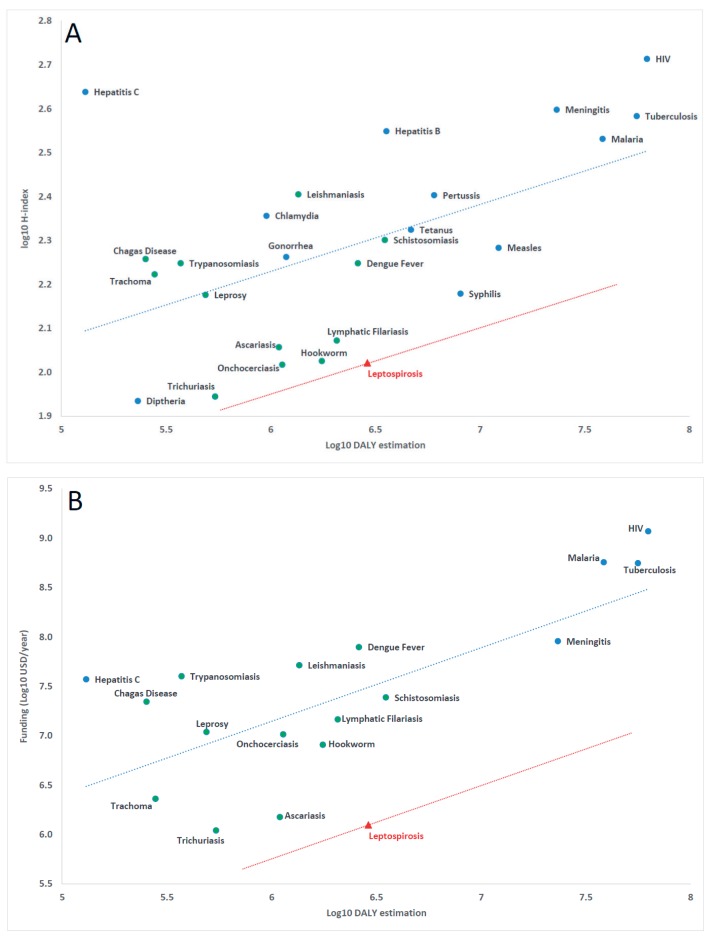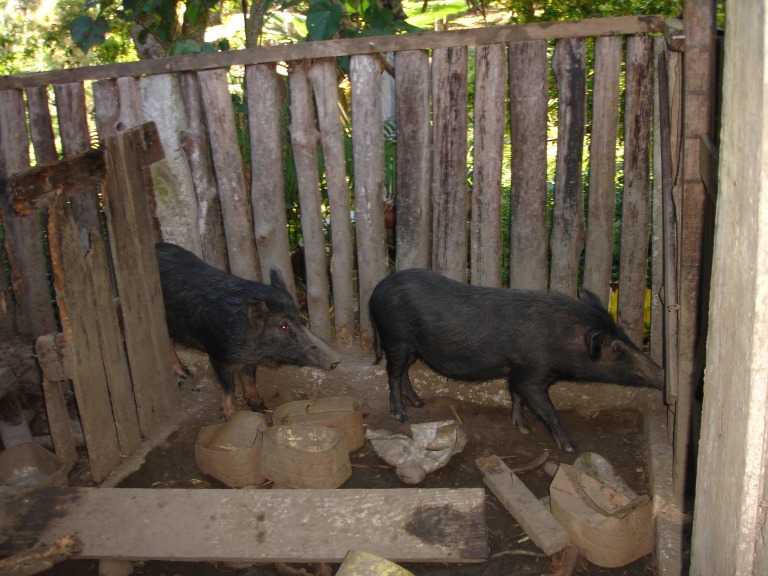Leptospirosis is a bacterial zoonotic disease that affects over 1 million humans, killing 58 900 every year [1]. It is mostly a disease of vulnerable populations affecting resource-limited people in urban slums and rural settings in developing countries. Leptospirosis also affects livestock and may cost developing economies hundreds of millions of dollars each year and further impoverish subsistence farmers.
Leptospirosis was identified as the only bacterial zoonosis whose impact will likely increase in response to global change in Europe [2], as expected from its numerous environmental drivers [3]. Indeed, recent reports suggest an actual rise in incidence in several European countries, including Germany, France, Croatia and the Netherlands [4].
However, leptospirosis was not considered in a recent systematic study of climate sensitivity of the most important European human and veterinary pathogens [5]. In this systematic study examining climate-sensitivity [5], a prioritization strategy was developed, which used the H-index scores to rank the ‘top’ pathogens’ (rather than diseases’) impact [6]. The H-index prioritisation strategy was validated using correlation between H-indices and global burden estimates for diseases expressed as disability-adjusted life years (DALYs) [7]. Scores for pathogens considered as ‘top pathogens’ ranged between 524 and 57.
We reanalysed the data, evaluating the reason for non-inclusion of leptospirosis. Although a unique disease entity, leptospirosis is caused by several Leptospira species; the highest H-index score was for Leptospira interrogans (H-index = 45), the name for all virulent leptospires until the 1980s. Leptospirosis was therefore not included in the review, because H-indices for the different virulent Leptospira species cannot be treated cumulatively, and no individual species H-index was above the 57 threshold. Re-analysis found that H-indices for “Leptospira” or “Leptospirosis” or “Leptospira OR leptospirosis” were higher than for single species alone, at 87, 87 and 105, respectively. These indices would have been inside the priority selection window. This omission could be corrected by considering disease entities linked to pathogens within search terms.
The global burden of leptospirosis was recently evaluated by a group of experts (Leptospirosis Epidemiology Research group) convened by World Health Organization (WHO). After extensive data collection and analysis, leptospirosis burden was estimated at 2.90 million DALYs [8]. If included in the correlation (Figure 1, panel A), it falls well below the regression line, providing evidence of insufficient research attention in relation to burden, the hallmark of neglect. Yet, leptospirosis is not included in the WHO list of neglected tropical diseases. Among the consequences identified, leptospirosis research is significantly under-resourced; the research area is unattractive to both funders (Figure 1, panel B, funding data from G-finder, see Table S1 in Online Supplementary Document) and researchers and the leptospirosis research community is shrinking due to lack of visibility and insufficient resources. In practical terms, no significant progress has been made to develop major areas beyond a leptospirosis vaccine [9] and the time-consuming diagnostic reference test for serology [10]; both were developed a century ago.
Figure 1.
Relationship between the global burden of disease (in DALYs estimated by World Health Organization (WHO) for 2015) and relative research impact (H-index score, calculated using Web of Knowledge and a search period from 1900 to 2018). This provides evidence for the neglect of leptospirosis in panel A. Relationship between the global burden of disease and research funding (annual funding in USD adjusted to 2016 US$, from G-finder) in panel B, confirming the negative impact on research resources in relation to leptospirosis burden. Green dots are for diseases classified as “neglected tropical diseases” by WHO, a red triangle defines leptospirosis; blue dots are for other diseases. Parallel to the linear regression line calculated using information for all diseases in each plot (blue), the red line illustrates the distance below the regression line for leptospirosis. Detailed data are available in Table S1 in Online Supplementary Document.
Photo: Backyard subsistence pig farming is probably a major source of leptospirosis in most of the Pacific Island Countries and Territories, where the highest burden is reported from around the globe (from C. Goarant, used with permission)
Leptospirosis, a severe, potentially fatal disease lays at the crossroads of several Sustainable Development Goals. It continues to inflict its high burden on the most vulnerable populations; especially those with least health infrastructure in the developing world, amidst almost total indifference. Breaking the vicious circle of neglect is urgent.
Additional Material
Acknowledgements
Thanks are due to Matthew Baylis for his contribution to the initial analysis. CG and MP are members of the Global Leptospirosis Environmental Action Network (GLEAN), which main purpose is to encourage action-oriented research on leptospirosis.
Footnotes
Funding: This study was conducted without specific funding resources
Authorship contributions: CG conceived the study. KMM and CG analysed the data. CG, MP, SM and KMM interpreted the results. All authors significantly contributed to the writing and editing of the MS and agreed with the final content.
Competing interests: The authors have completed the Unified Competing Interest form at www.icmje.org/coi_disclosure.pdf (available on request from the corresponding author) and declare no conflict of interest.
REFERENCES
- 1.Costa F, Hagan JE, Calcagno J, Kane M, Torgerson P, Martinez-Silveira MS, et al. Global morbidity and mortality of leptospirosis: A systematic review. PLoS Negl Trop Dis. 2015;9:e0003898. doi: 10.1371/journal.pntd.0003898. [DOI] [PMC free article] [PubMed] [Google Scholar]
- 2.Dufour B, Moutou F, Hattenberger AM, Rodhain F. Global change: impact, management, risk approach and health measures–the case of Europe. Rev Sci Tech. 2008;27:529–50. doi: 10.20506/rst.27.2.1817. [DOI] [PubMed] [Google Scholar]
- 3.Mwachui MA, Crump L, Hartskeerl R, Zinsstag J, Hattendorf J. Environmental and behavioural determinants of leptospirosis transmission: A systematic review. PLoS Negl Trop Dis. 2015;9:e0003843. doi: 10.1371/journal.pntd.0003843. [DOI] [PMC free article] [PubMed] [Google Scholar]
- 4.European Centre for Disease Prevention and Control ECDC. Leptospirosis - Annual Epidemiological Report for 2015. Stockholm: ECDC, 2018. [Google Scholar]
- 5.McIntyre KM, Setzkorn C, Hepworth PJ, Morand S, Morse AP, Baylis M. Systematic assessment of the climate sensitivity of important human and domestic animals pathogens in Europe. Sci Rep. 2017;7:7134. doi: 10.1038/s41598-017-06948-9. [DOI] [PMC free article] [PubMed] [Google Scholar]
- 6.McIntyre KM, Setzkorn C, Hepworth PJ, Morand S, Morse AP, Baylis M. A Quantitative Prioritisation of Human and Domestic Animal Pathogens in Europe. PLoS One. 2014;9:e103529. doi: 10.1371/journal.pone.0103529. [DOI] [PMC free article] [PubMed] [Google Scholar]
- 7.McIntyre KM, Hawkes I, Waret-Szkuta A, Morand S, Baylis M. The H-index as a quantitative indicator of the relative impact of human diseases. PLoS One. 2011;6:e19558. doi: 10.1371/journal.pone.0019558. [DOI] [PMC free article] [PubMed] [Google Scholar]
- 8.Torgerson PR, Hagan JE, Costa F, Calcagno J, Kane M, Martinez-Silveira MS, et al. Global rurden of Leptospirosis: Estimated in terms of Disability Adjusted Life Years. PLoS Negl Trop Dis. 2015;9:e0004122. doi: 10.1371/journal.pntd.0004122. [DOI] [PMC free article] [PubMed] [Google Scholar]
- 9.Ido Y, Hoki R, Ito H, Wani H. The prophylaxis of Weil’s disease (Spirochaetosis Icterohaemorrhagica). J Exp Med. 1916;24:471–83. doi: 10.1084/jem.24.5.471. [DOI] [PMC free article] [PubMed] [Google Scholar]
- 10.Martin L, Pettit A. Sero-diagnostic de la spirochaetose icterohaemorrhagique. Bull Mem Soc Med Hop Paris. 1918;42:672–5. [Google Scholar]
Associated Data
This section collects any data citations, data availability statements, or supplementary materials included in this article.




